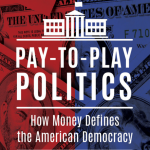Disconnect between campaign promises and political reality
Daily 202: Reprinted courtesy of Washington Post
February 2018 / News & Opinion
THE BIG IDEA: President Trump campaigned like a populist, but the budget he proposed February 12th underscores the degree to which he’s governing as a plutocrat.
Many of his proposals are dead on arrival in Congress, but the blueprint nonetheless speaks volumes about the president’s values — and contradicts many promises he made as a candidate.
“This is a messaging document,” Trump budget director Mick Mulvaney told reporters at the White House.
Here are eight messages that the White House sends with its wish list:
- Touching third rails he said he wouldn’t:
As a candidate, Trump repeatedly said he would never cut Medicare, Medicaid or Social Security.
Now he proposes cutting Medicare by $554 billion and Medicaid by around $250 billion over the next decade.
His plan includes new per-person limits on the amount of health care each Medicaid enrollee can use and a dramatic shift toward block grants, which would allow states to tighten eligibility requirements and institute work requirements that would kick some off public assistance.
Impacting the middle class, Trump also calls for cutting the subsidies that allow more than four in five people with marketplace health plans to afford their insurance premiums under the Affordable Care Act.
- Scaling back support for the forgotten man:
Many displaced blue-collar workers in the Rust Belt took the president at his word when he promised to bring back their manufacturing jobs. But Trump’s budget calls for cutting funding for National Dislocated Worker Grants — which provides support to those who lose their jobs because of factory closures or natural disasters — from $219.5 million in 2017 to $51 million in 2019.
Also at the Labor Department, the president wants to slash support for the Adult Employment and Training Activities initiative, which serves high school dropouts and veterans, from $810 million last year to $490 million in 2019.
- Giving up on a balanced budget:
Trump repeatedly promised that he would balance the budget “very quickly.” It turns out that a guy who has often described himself as the “king of debt” didn’t feel that passionately about deficits. Last year, he laid out a plan to balance the budget in 10 years. This year he didn’t even try. Trump now accepts annual deficits that will run over $1 trillion as the new normal.
Going further, the president also promised on the campaign trail that he’d get rid of the national debt altogether by the end of his second term. But his White House now projects that the national debt, which is already over $20 trillion, will grow more than $2 trillion over the next two years and by at least $7 trillion over the next decade. The administration repeatedly denied this in December as officials pushed to cut taxes by $1.5 trillion.
“After Ronald Reagan’s tax cuts in the 1980s, deficits exploded in the same range as Trump’s now, when calculated as a percentage of the economy, or gross domestic product. But Reagan’s famous ‘riverboat’ gamble came when the total national debt was a fraction of what it is today. Trump is pushing the envelope when debt is already near 80 percent of GDP, leaving far less room to maneuver if the economy turns downward,” David Rogers writes in Politico. “Economists and politicians alike don’t know what happens next. There’s all the edginess of breaking new ground. But also, as with Faulkner’s famous line, there is a sense that the past ‘is not even past.’ … Nothing now seems obvious, except red ink.”
Trump blames state of U.S. infrastructure on ‘laziness’ after WWII
President Trump said on Feb. 12 that the decline in U.S. infrastructure and increase in the deficit was caused by “laziness.” (The Washington Post)
- Relying on fuzzy math:
Trump’s team knows full well that they’ll never get most of the spending cuts they’re proposing, but they’re using them to make the deficit look less bad than it really is. Just last Friday, the president signed into law an authorization bill that blows up the sequester and increases spending by more than $500 billion.
The White House also makes the unrealistic assumption that the economy will grow by more than 3 percent every year between now and 2024, which makes its projections for revenue growth rosier than they should be. No serious economist thinks that level of growth can be sustained. A recession seems probable in the next decade.
Senate Democrats noticed that Trump’s budget plan, if it was enacted, would actually result in a net decrease in federal spending on infrastructure. Chuck Schumer’s office identified more than $240 billion in proposed cuts over the coming decade to existing infrastructure programs, which is higher than the $200 billion Trump simultaneously proposed in new spending. “The cuts identified by Schumer’s office include a $122 billion reduction in outlays over the coming decade to the Highway Trust Fund, which pays for road projects and mass transit,” John Wagner reports. “Other proposed reductions would target an array of programs that fund rail, aviation [and] wastewater.”
- Paying for tax cuts that mostly benefit the rich by cutting holes in the safety net
for the poor:
In 1999, then-Texas Gov. George W. Bush denounced a House Republican plan to save $8 billion by deferring tax credit payments for low-income people. “I don’t think they ought to balance their budget on the backs of the poor,” he said at a campaign stop. “I’m concerned for someone who is moving from near-poverty to middle class.”
That sentiment seems quaint now. While Trump has never claimed the mantle of “compassionate conservatism,” his budget validates several of the negative stereotypes that Bush tried to shed.
This is a budget for the haves. The have-nots get left behind.
Trump wants to cut $214 billion from the food stamp program in the next decade, a reduction of nearly 30 percent.
The budget shows Ben Carson has no suction at the White House. Despite his efforts, the secretary of housing and urban development was unable to stop Trump from reducing Section 8 federal housing subsidies by more than $1 billion, zeroing out community development block grants and eliminating a $1.9 billion fund to cover public housing capital repairs. The 14 percent cut at HUD is even deeper than what Trump proposed last year.
The budget cuts 29 programs at the Education Department, many of which are designed to help needy children — including after-school activities to keep kids off the street and a grant program for college students with “exceptional financial need.” Trump’s plan also gets rid of a tuition initiative that makes college affordable for underprivileged D.C. residents, who don’t have access to strong in-state universities.
- Deconstructing the administrative state:
Trump wants to neuter the Consumer Financial Protection Bureau by starving it of resources, limiting its enforcement power and changing its funding stream so that it’s more vulnerable to pressure from Wall Street.
He seeks to cut more than $2.5 billion from the annual budget of the Environmental Protection Agency, which is about a quarter of its spending. He’d eliminate funding for state radon-detection programs and end partnerships to monitor and restore water quality in the Gulf of Mexico, Puget Sound and other large bodies of water.
“Funding for the restoration of the Chesapeake Bay would fall from $72 million to $7 million, and a similar program for the Great Lakes would be cut from $300 million to $30 million — although neither would be wiped out,” Brady Dennis reports. “In addition, the Trump budget would eliminate — or very nearly eliminate — the agency’s programs related to climate change. Funding for the agency’s Office of Science and Technology would drop by more than a third, from $762 million to $489 million. And funding for prosecuting environmental crimes and for certain clean air and water programs would drop significantly.”
- More guns, less butter:
Make no mistake, Trump is not calling for a reduction in the size of government. He seeks to spend $4.4 trillion next year, up 10 percent from last year. He’s calling for spending less on the homefront to cover a massive military buildup.
Trump asks for $716 billion in defense spending in 2019, a 13 percent increase. “The Trump plan provides more money for just about everything a general or admiral might desire,” Greg Jaffe notes. “The United States already spends more on its military than the next eight nations combined.”
Meanwhile, Trump proposes slashing the State Department’s budget by 23 percent. As Secretary of Defense James Mattis told Congress in 2013, when he was a Marine general leading Central Command: “If you don’t fully fund the State Department, then I need to buy more ammunition.”
Another campaign promise Trump is making good on: building his “Deportation Force.” The budget allocates $2.8 billion to expand immigration detention facilities so that 52,000 beds are always available, $782 million to hire 2,750 additional border agents, and $1.6 billion for the construction of 65 miles of border wall in Texas. (Whatever happened to Mexico paying?) He also adds $2.2 billion for the Secret Service to hire 450 more people.
Trump claims that U.S. has spent “$7 trillion in the Middle East” and “the Middle East is far worse now than it was 17 years ago.”(The Washington Post)”
(Military spending in the new budget will increase this “more guns, less butter” trend)
- Leaning in on privatization:
Trump wants to outsource as many public functions as possible to private, for-profit companies.
His budget calls for selling off scores of prized federal assets, from Reagan National and Dulles Airports to the George Washington Memorial Parkway and the Baltimore-Washington Parkway. “Power transmission assets from the Tennessee Valley Authority; the Southwestern Power Administration, which sells power in Arkansas, Kansas, Louisiana, Missouri, Oklahoma, and Texas; the Western Area Power Administration; and the Bonneville Power Administration, covering the Pacific northwest, were cited for potential divestiture,” Michael Laris reports. “It was not immediately clear what public or private entity might buy those roads, whether they might be tolled, or other details. Some state officials said they were uncertain about how their residents would benefit from such a proposal.”
The White House is re-upping its plan to shift the nation’s air traffic control system out of government hands, even though it went nowhere in Congress last year.
Trump proposes to end funding for the International Space Station after 2024 by privatizing the orbiting laboratory.
Finally, he wants to increase spending by more than $1 billion on private school vouchers and other school choice plans while slashing the Education Department’s budget by $3.6 billion and devoting more resources to career training, at the expense of four-year universities.
# # # #




